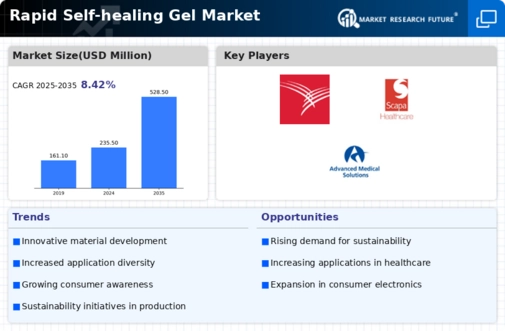Rapid Self Healing Gel Size
Rapid Self healing Gel Market Growth Projections and Opportunities
Rapid Self-healing Gel market is influenced by several factors that shape its dynamics collectively. This market has been driven mainly by the healthcare and biomedical industry, where Rapid Self-healing Gels are used in wound care, drug delivery systems and tissue engineering process. The rapid self-healing gel market is growing due to investigation on new medical technologies and innovative solutions for quick healing of wounds. Demand keeps rising for such gels as health care providers and researchers seek to improve patient’s outcomes in the global world.
There a number of scientific and technological advancements that are responsible for changing the way Rapid Self-healing Gels operate. The continuous research and development aiming at improving their properties, biocompatibility as well as applications contribute to the growth of such gels’ markets. Innovations in materials science, polymer chemistry and bioengineering further enhance better Rapid Self-healing Gels leading them to be regarded as state-of-the-art latest medical field interventions.
The demographic landscape plays a significant role in shaping the dynamics of Rapid Self-healing Gels’ market including an aging population. The increasing elderly population across the globe leads to increased cases of chronic wounds thereby enhancing advanced wound care demands. As such, Rapid Self-Healing Gels become indispensable in meeting healthcare needs for these populations owing to their abilities in promoting healing.
Environmental sustainability is an emerging factor influencing the Rapid Self-healing Gel market. As eco-friendly practices gain popularity, there is a growing need for sustainable biomaterials. In light of this trend, manufacturers of rapid self-healing gels are investigating how they can develop environmentally friendly formulations and production processes which will match up with the needs of environmentally conscious consumers or even healthcare providers.
Consumer awareness n preferences within the health sector also forms part of this dynamic set-up hence contributing towards determining market dynamics associated with Rapid-Self Healing Gels (McCarthy et al., 2018). Patients together with healthcare professionals are increasingly seeking for solutions that can offer faster healing outcomes, shorter recovery periods and better patient experience. They have properties that cater for these needs and align with the changing expectations of the healthcare community.
Competition within the biomedical and healthcare industries is a significant factor in the Rapid Self-healing Gel market. This is because firms undertake research and development so as to be ahead thus creating formulas that have stronger healing properties with a broader scope of applications. The competition among different players in this field can be influenced by brand reputation, strategic alliances as well as effective marketing strategies.







Leave a Comment